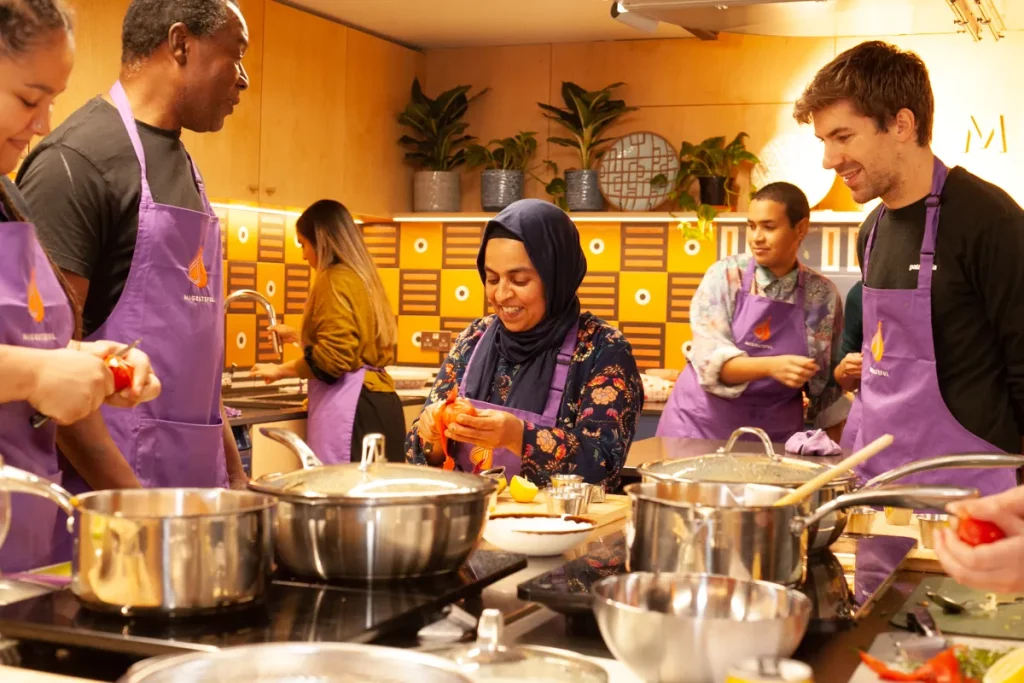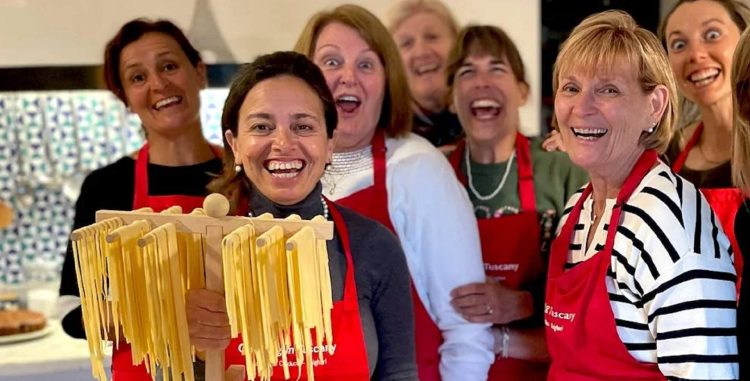In today’s fast-paced world, where convenience often trumps nutrition, cooking classes are emerging as a powerful tool to promote healthy eating and strengthen community ties. These group cooking sessions not only teach participants how to prepare nutritious and flavorful meals, but they also offer an opportunity for individuals to connect with others, share knowledge, and create lasting relationships. Cooking classes have gained popularity worldwide, transcending cultural and generational boundaries to become an essential part of community engagement. In this article, we’ll explore how group cooking sessions are helping to foster healthy eating habits, encourage cultural exchange, and build stronger, more supportive communities.
The Role of Cooking Classes in Promoting Healthy Eating
Cooking classes are an invaluable resource in helping individuals make informed decisions about their diet. In an age of processed foods and pre-packaged meals, many people are disconnected from the fundamental skills needed to prepare fresh, nutritious meals. By teaching people how to cook from scratch, these classes empower participants to take control of their health and improve their overall well-being.
Education on Nutritious Ingredients
One of the primary benefits of cooking classes is the education they provide on nutritious ingredients and healthy cooking techniques. Participants are often introduced to fresh produce, lean proteins, whole grains, and healthy fats, which they may not be familiar with or may not know how to incorporate into their meals. By learning about the benefits of these ingredients, individuals can make better food choices that are both satisfying and nutritious. Moreover, cooking classes often focus on cooking methods that preserve the nutritional value of foods, such as steaming, roasting, and sautéing, rather than frying or overcooking.
For example, in many classes, participants learn how to make wholesome dishes like vegetable stir-fries, grain bowls, or homemade soups using fresh, seasonal ingredients. These classes teach the importance of portion control, how to balance macronutrients, and how to minimize the use of added sugars, salt, and unhealthy fats.
Improving Cooking Skills and Confidence
Cooking classes also serve as a platform for individuals to enhance their cooking skills and boost their confidence in the kitchen. Many people are intimidated by the thought of preparing healthy meals from scratch, and often resort to takeout or processed options because they feel that cooking is time-consuming or complicated. By providing hands-on experience and guidance, cooking classes demystify the process of preparing fresh meals and make cooking feel approachable.
As participants gain practical skills and experience, they become more comfortable experimenting with new ingredients and recipes. This increased confidence can lead to long-term changes in eating habits, as individuals feel more empowered to make healthy meals at home rather than relying on pre-packaged options. This not only improves their diet but also saves money and reduces food waste.
Building Community Through Cooking
In addition to promoting healthy eating, cooking classes play a significant role in strengthening community bonds. These group cooking sessions offer a space for people to come together, share experiences, and form meaningful connections. Whether it’s through cooking in small teams, sharing a meal together afterward, or simply engaging in conversation while preparing food, cooking classes create a sense of camaraderie and belonging.
Encouraging Collaboration and Teamwork
Group cooking classes often require participants to work together in teams to prepare meals. This collaborative aspect fosters teamwork and helps individuals develop social skills, as they need to communicate, delegate tasks, and support each other to achieve a common goal. Working side by side in the kitchen also provides a natural setting for individuals to bond over shared experiences, creating a sense of unity and mutual respect.
For example, participants might team up to chop vegetables, stir sauces, or roll dough, all while learning from one another. This hands-on collaboration creates a fun and relaxed environment where participants can connect with people they may not have met otherwise. The shared experience of cooking together often results in friendships and lasting relationships, which extend beyond the class.

Creating a Sense of Belonging
Cooking classes also help create a sense of belonging within a community. For individuals who may feel isolated or disconnected, these classes offer an opportunity to interact with others in a positive, supportive environment. In many cases, cooking classes are held in local community centers, schools, or cultural hubs, which serve as gathering spaces for people from diverse backgrounds. This inclusivity helps to break down barriers and foster a sense of shared identity.
In addition to fostering a sense of community, cooking classes can also serve as a platform for cultural exchange. Participants often come from different cultural backgrounds and bring unique culinary traditions and flavors to the table. This diversity enriches the cooking experience, as people share their personal stories, recipes, and techniques with one another. Over time, these interactions promote mutual understanding and appreciation, creating a more harmonious and connected community.
Intergenerational Bonding
Cooking classes also provide a unique opportunity for intergenerational bonding. Many cooking sessions are designed to be family-friendly, allowing parents and children to cook together, or for older generations to share their cooking knowledge with younger ones. These intergenerational activities help preserve culinary traditions, while also fostering understanding between different age groups.
For example, a grandmother might teach her grandchildren how to make traditional dishes that have been passed down through generations, instilling a sense of cultural pride and continuity. On the other hand, younger participants may introduce modern twists on traditional recipes, encouraging creativity and innovation in the kitchen. This exchange of ideas strengthens family and community ties, creating a supportive network where knowledge and traditions are shared across generations.
Mental Health Benefits of Group Cooking
Cooking classes not only promote physical health but also offer numerous mental health benefits. The act of preparing food has been shown to reduce stress, increase mindfulness, and boost mood. Group cooking sessions, in particular, provide a therapeutic and engaging activity that can help individuals cope with mental health challenges and improve their overall well-being.
Reducing Stress and Anxiety
Engaging in hands-on activities such as cooking can have a calming effect on the mind. The repetitive motions of chopping, stirring, and kneading can help individuals focus on the task at hand and quiet their thoughts, promoting mindfulness. This mindful approach to cooking encourages participants to be present in the moment, which can be especially beneficial for those dealing with stress or anxiety.
Moreover, the social aspect of group cooking helps alleviate feelings of loneliness and isolation. Sharing a cooking experience with others creates a sense of connection and support, which can improve emotional well-being. The shared joy of preparing a meal together can boost feelings of happiness and fulfillment, making it an effective way to combat negative emotions and mental health struggles.
Boosting Self-Esteem and Confidence
Cooking classes also have the potential to boost self-esteem and confidence. Successfully preparing a meal from scratch is an empowering experience that gives individuals a sense of accomplishment and pride. For many, this newfound confidence in the kitchen extends to other areas of life, as they feel more capable of handling challenges and trying new things.
In addition to the personal sense of achievement, group cooking sessions also provide positive reinforcement from peers and instructors. The supportive environment encourages participants to celebrate their successes and learn from mistakes, fostering a growth mindset and a sense of community pride.
How to Get Involved in Cooking Classes
Getting involved in cooking classes is easy, and there are a variety of ways to participate. Many community centers, local non-profit organizations, and cultural institutions offer affordable cooking classes that are open to individuals of all skill levels. Alternatively, you can look for online cooking courses or workshops that offer virtual group sessions.
Before joining a class, it’s important to consider your dietary preferences and goals. Many cooking classes are designed to cater to specific dietary needs, such as vegetarian, vegan, gluten-free, or low-carb cooking. This allows participants to learn how to create meals that align with their health goals while still enjoying delicious and satisfying dishes.
Conclusion
Cooking classes are more than just a way to learn how to prepare food—they are a vital tool for promoting healthy eating, building community, and improving mental well-being. By teaching individuals how to cook nutritious meals from scratch, these classes empower participants to take control of their health and make more informed food choices. At the same time, the collaborative nature of cooking classes fosters strong social bonds, encourages cultural exchange, and creates a sense of belonging. In a world where fast food and convenience often dominate, cooking classes offer a refreshing opportunity to reconnect with food, one another, and ourselves. Whether you’re cooking with family, friends, or strangers, group cooking sessions have the potential to transform not only your diet but also your sense of community and overall well-being.

















































